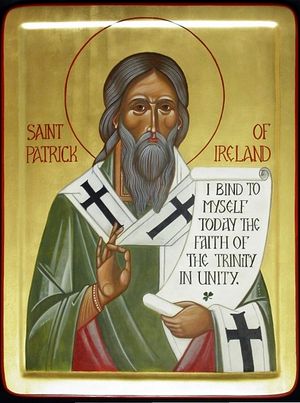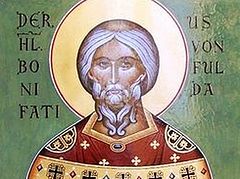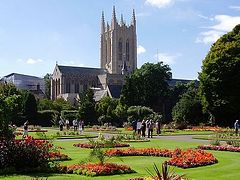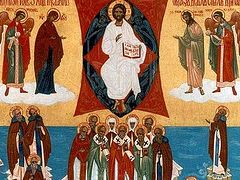Moscow, March 10, 2017
St. Patrick, the great enlightener of Ireland, will be officially celebrated in the Russian Orthodox Church for the first time this year on March 17/30. At its March 9 session, the Holy Synod of the Russian Orthodox, under the chairmanship of His Holiness Patriarch Kirill, officially adopted St. Patrick and more than fifteen other pre-schism Western saints into its calendar, according to the report published on the patriarchate’s official site.
The decision was taken after hearing a report from His Eminence Metropolitan Clement of Kaluga and Borovsk, chairman of the commission for the compilation of the Russian Orthodox Church’s Menaion, or calendar of saints, with the proposal to include several ancient saints who labored in western lands before the Great Schism of 1054.
The commission, created on September 18, 2014 by the blessing of His Holiness, had been working on compiling a list of western saints guided by the following criteria: their unblemished confession of the Orthodox faith; the circumstances in which their glorification took place; the absence of their names from polemical works against the Eastern Church and rite; and their present veneration in foreign dioceses of the Russian Orthodox Church and other Local Churches.
Also considered were the “Complete Menaion of the East” by Archbishop Sergius (Spassky), the report of St. John Maximovitch to the Holy Synod of the Russian Church Abroad in 1952, the articles of the Orthodox Encyclopedia and the Snaxarion compiled by Hiermonk Macarius of the Athonite monastery of Simenopetra.
The Western saints added into the calendar of the Russian Orthodox Church are:
Hieromartyr Pothinus, bishop of Lyons, and those with him
(June 2/15; c. 177)
Martyrs Blandina and Ponticus of Lyons (June 2/15; c.
177)
Martyr Epipodius of Lyons (April 22/May 5; c. 177)
Martyr Alexander of Lyons (April 24/May 7; c. 177)
Hieromartyr Saturninus, first bishop of Toulouse (November
29/December 12; c. 257)
Martyr Victor of Marseilles (July 21/August 3; c.
290)
St.
Alban, protomartyr of Britain (June 22/July 5; c.
304)
St. Honoratus, archbishop of Arles and founder of Lerins
Monastery (January 16/29; 429)
St. Germanus, bishop of Auxerre (July 31/August 13;
448)
St. Vincent of Lerins (May 24/June 6; c. 450)
St.
Patrick, bishop of Armagh, and enlightener of Ireland
(March 17/30; 451)
St. Lupus the Confessor, bishop of Troyes (Gaul) (July
29/August 11; 479)
St.
Genevieve of Paris (January 3/16; 512)
St. Germanus, bishop of Paris (May 28/June 10; 576)
St. Procopius, abbot of Sazava in Bohemia (September
16/29; 1053)
Also approved and recommended for Church-wide liturgical use was the texts of the service to the Synaxis of Saints of Diveevo, the service to St. Hilarion of Optina, and the troparion and kontakion to St. Adrian of Ondrusov.





To begin with I have to admit that I generally do not agree with your statement. It would be helpful if you are willing to reply to the following qquestions: How would you define the Church of the first millennium - why would you reject to call it Orthodox ? What do you mean by "falsified history" ?
May there be ongoing unison of ministry between all Churches to share outwardly for His mission. Obrigado
We remember that at the time of St Maximos the Confessor, the West was more Orthodox than the East. St Theodore of Tarsus came to England in 669 and was Archbishop of Canterbury. In 679, he called the Synod of Hatfield to test the Orthodox purity of the English bishops because the Greek East had suffered from the Monophysite heresy whereas the West was purely Orthodox.
There is a cloud of Orthodox saints in the British Isles from the first century until the catastrophe of 1066. Princess Gytha, daughter of Harold, the last Orthodox King of England, fled to Russia and married Vladimir II Monomakh and so became the mother of Russian saints and rulers.
The faithful of these lands who have embraced Holy Orthodoxy have returned to their ancient roots. As to saints in the Russian calendar, I would plead the case of St John of Beverley ( 721) – see my article on this great saint here on pravoslavie.ru/English
Margaret McFadden Mueller
But let's also be absolutely clear about something. Orthodox Christianity is not native to the British Isles. Orthodoxy did not arrive in the British Isles until immigrants from Eastern Europe showed up. Orthodoxy is as foreign to the British Isles as Buddhism, Hinduism, or Islam. That a lot of the attempts to suggest that these saints were Orthodox are grounded in falsified history, which in turned is motivated by only so much puerile nationalism.
As a person of Western descent, it's helpful to have historical ties to recognized saints from my own ancestral tradition. I know that shouldn't be necessary, but the instinctive longing for a connection to the faith of my fathers and mothers is among the factors that brought me into the Church.
This drive is akin to nostalgia for something I had never known. It welled up in young adulthood, and I've been chasing it ever since. Regrettably, the foreign aspect of Orthodox liturgical traditions and national cultures has often been a stumbling block.